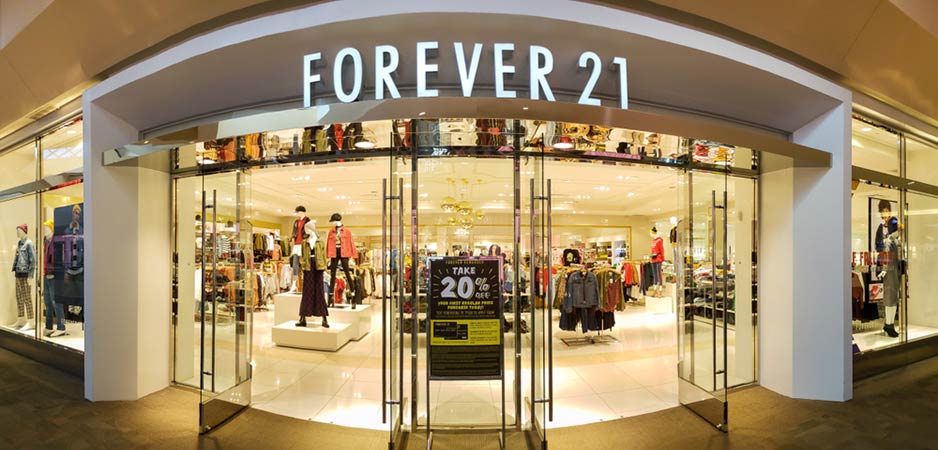From its reign as king of the mall just a few years ago to its tumble into bankruptcy court last month, Forever 21 is a spectacular success story that seems destined for an unhappy ending.
South Korean immigrants Jin Sook and Do Wan Chang started the chain in 1984 with $11,000 that they saved from working in low-paying service jobs. Their first store was a 900-square-foot space in Northeast Los Angeles that offered cheap and trendy clothing to a young, mostly Korean-American clientele.
But the couple had a plan. Their fast-fashion business model, which was based on quick-turnaround designs that could be inexpensively mass-produced, proved wildly popular with young customers who didn’t have much money to spend but wanted the latest looks. By 2015, global sales peaked at $4.4 billion, with 480 stores occupying enormous spaces in malls across America, according to Business Insider. Sook and Chang became wealthy, with a combined estimated net worth of nearly $6 billion.
However, the couple didn’t anticipate the so-called retail apocalypse, which began in 2017 and continues to threaten virtually every retail chain. More than 8,200 stores in the US have closed this year, according to Coresight Research. The firm anticipates 12,000 closures by year’s end, eclipsing the 5,844 closures in 2018.
The rapidly changing retail sector put too much pressure on Forever 21, and the privately-held company filed for Chapter 11 bankruptcy in late September. It announced that it will cease operations in 40 countries, including Canada and Japan, and close 350 of its 800 stores, including 178 in the US.
The dramatic rise and fall of Forever 21 is a story that repeats in similar fashion across the retail landscape, but there are some factors specific to the chain’s troubles. Wharton marketing Professor Barbara Kahn and Ludovica Cesareo, a marketing professor at Lehigh University, analyzed the case on the Knowledge@Wharton radio show and outlined three distinct reasons why Forever 21 failed to stay on top.
Too Many Stores, Too Much Space
Forever 21 expanded rapidly in a short period of time, going from outlets in seven countries to 47 in just six years. Even as other chains were downsizing amid the retail apocalypse, Forever 21 was opening new stores as late as 2016.
“It’s kind of like the Gap, where they overbuilt the stores, too,” said Kahn, who also hosts “Marketing Matters” on Sirius XM. “They weren’t seeing the trends, and instead of slowing down on physical space, they were building up physical space. That was a tactical mistake.”
It isn’t just the number of stores that is problematic, it’s also their size. Forever 21 stores are huge, with the average size at 38,000 square feet, according to the company’s website. The largest store is multiple stories and takes up 162,000 square feet. The Times Square store in New York City is 91,000 square feet, and a mall store in Las Vegas spans 127,000 square feet.
All that space is expensive, the experts said. Sales reportedly dropped by 20% to 25% last year, which means the company likely struggled to pay the high rents demanded by premier spots while facing increased competition from Zara and H&M, the other big players in the fast-fashion segment.
“A lot of [Forever 21] stores were big footprints — almost as big as department stores in some of the malls,” Kahn said. “When they close down, it’s kind of like an anchor closing down. It doesn’t bode well for those malls, either.”
The company’s rapid expansion in recent years is opposite to the business strategy currently being deployed by retailers trying to save themselves from extinction. Many chains are closing their big stores and moving to smaller footprints and mini-shops as a way to shrink costs while maintaining consumer access to their brands. Even big-box retailers like Target are opening smaller stores in metropolitan areas, where big retail space is hard to find.
Meanwhile, “digital native brands — think of the Warby Parkers or the Caspers of the world – they’re opening stores,” said Cesareo, whose research specialty includes consumer behavior. “You would say it almost wouldn’t make sense, but they are opening these small pop-up shops and flagship stores where consumers can actually experience the brands firsthand. There’s more of a shakeout in retail than a full apocalypse right now. Retail is just repositioning itself.”
A Weak Focus on E-Commerce
Another big failure for Forever 21 is particularly baffling to Cesareo. She said the company didn’t bolster its e-commerce platform, even though its core customers are young people who prefer to shop online.
“It’s fascinating that they couldn’t predict that shift, so now they’re forced to restructure their entire company and really put pressure on their online commerce platform to try to make up for the lost sales,” she said.
Digital has become such an important component to retail that most stores cannot survive without it. For brands that target younger consumers, digital drives their business. Forever 21 has stated that 16% of sales come from online, and Cesareo praised the site for being user-friendly. In fact, she said, it’s highly rated in surveys by Generation Z shoppers — defined as those born after the year 2000. The company also has good customer interaction, reposting a lot of social media content from their customers that showcases the store’s products.
“So they’re good at doing it, except they didn’t realize that’s where consumers wanted to buy most of their clothing, and they also didn’t realize the amount of competition coming from other online retailers was skyrocketing,” she said. “Think of brands like ASOS or Fashion Nova, whose entire business model is online. They have understood that the customer of the future is a digital-savvy one who wants to buy online, who prefers to buy something online and return if they don’t like it or don’t have a need for it, rather than going into the store to try it on.”
Kahn argued that customers still like the experience of shopping in physical stores, and she and Cesareo agreed that stores have to reinvent themselves.
“Bad, out-of-date retail that’s not paying attention to the trends, those are the ones that are closing. But to say physical stores don’t have a purpose, I just don’t think that’s right,” Kahn said. “I think you just have to pay attention to what’s going on and what people want.”
The Move Toward Sustainability
Perhaps the biggest mistake made by Forever 21 was its leadership’s inability to read the tea leaves and see a significant shift in consumer attitudes about fast fashion. That business model worked well until the world woke up to the pressing problems of climate change.
According to the United Nations, the fashion industry produces 20% of the world’s wastewater and 10% of global carbon emissions — more than all international flights and maritime shipping. With its focus on synthetic fabrics and quick manufacturing time, fast fashion has been shouldering much of the blame for those statistics because it produces tremendous waste.
Young people are leading the charge for sustainability, demanding that businesses reduce their devastating impact on the environment. Customers that once flocked to fast-fashion stores like Forever 21 are abandoning them in favor of clothing that isn’t disposable.
“I think fast fashion as we know it is not going to exist for much longer, meaning they’re going to have to completely rethink their business model because the younger consumer is so attentive to sustainability issues,” Cesareo said. “The younger consumer wants to spend more money on higher-quality clothes, so they’re less likely to go to Zara 17 times a year as they did in the past because they just care more about the environment, and they know that these companies don’t really have sustainability at the heart of what they do.”
Gen Zers are demanding change and want to see their values reflected in their favorite brands. Companies including Forever 21 must show their sustainability efforts not just through their products but also in their marketing, messaging and online engagement with customers, Cesareo said.
She and Kahn credited Zara and H&M for rolling out sustainable collections this fall, and they highlighted the growing trend toward upcycling, recycling and renting clothes.
Forever 21 built its model on “trying to have this fashion come in, and in style, very, very quickly. The clothes aren’t necessarily supposed to hold up for a while. They’re only a couple of wears because they’re so trendy,” Kahn said. “At the same time they’re doing that, there’s a lot of headwind for sustainability efforts and renting and sharing and not making clothes that get thrown away.”
Kahn does cut the company some slack. After all, she said, predicting what young consumers want is difficult because they change their minds so quickly that it’s hard to keep up.
“They’re fickle. That’s the point,” she said. “They’re revolting about what’s there, they want to do something new, and it’s kind of hard to figure out what their trends will be.”
Still, the professors believe the sustainability movement is here to stay. The company will have to get on board as part of its survival — if it can survive.
In a letter posted to customers on its site, Forever 21 emphasized that it is not shutting down. “We are confident this is the right path for the long-term health of our business. Once we complete a reorganization, Forever 21 will be a stronger, more viable company that is better positioned to prosper for years to come,” the letter states.
The professors remain skeptical. Cesareo said she’s waiting to see whether Forever 21 takes on some of the strategies that are helping other retailers succeed, including smaller stores, ship-to-store options and sustainable products. Kahn said it’s imperative that they restructure properly.
“One can only hope,” she said. “We see a lot of these brands that come back and they just don’t seem to get it, so I hope they do.”
*[This article was originally published by Knowledge@Wharton, a partner institution of Fair Observer.]
The views expressed in this article are the author’s own and do not necessarily reflect Fair Observer’s editorial policy.
Support Fair Observer
We rely on your support for our independence, diversity and quality.
For more than 10 years, Fair Observer has been free, fair and independent. No billionaire owns us, no advertisers control us. We are a reader-supported nonprofit. Unlike many other publications, we keep our content free for readers regardless of where they live or whether they can afford to pay. We have no paywalls and no ads.
In the post-truth era of fake news, echo chambers and filter bubbles, we publish a plurality of perspectives from around the world. Anyone can publish with us, but everyone goes through a rigorous editorial process. So, you get fact-checked, well-reasoned content instead of noise.
We publish 2,500+ voices from 90+ countries. We also conduct education and training programs
on subjects ranging from digital media and journalism to writing and critical thinking. This
doesn’t come cheap. Servers, editors, trainers and web developers cost
money.
Please consider supporting us on a regular basis as a recurring donor or a
sustaining member.
Will you support FO’s journalism?
We rely on your support for our independence, diversity and quality.






